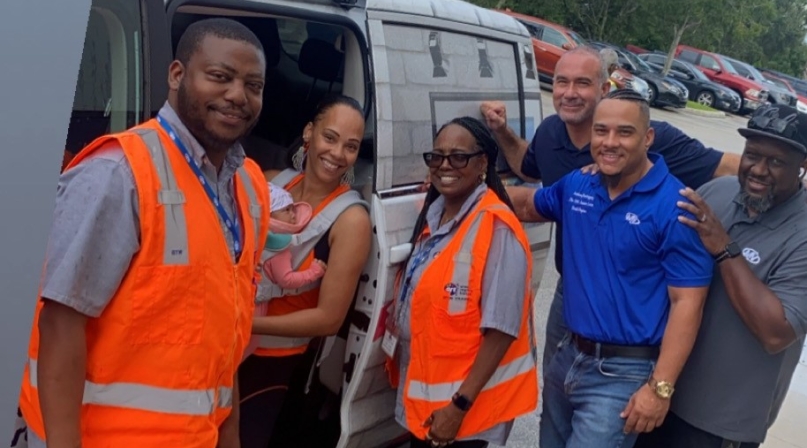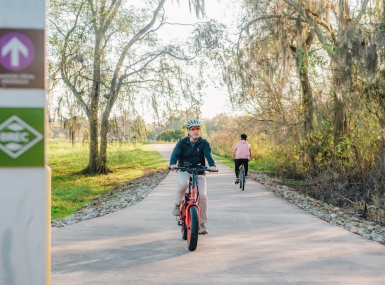Florida county’s ‘micro-transit’ program offers first and last-mile solutions for areas without bus routes

Key Takeaways
Jay Foxe was seven months pregnant and new to St. Lucie County, Fla. when she got into a car accident. Her vehicle was totaled, and Foxe — who lives in a rural part of the county — was left unsure how she would get to her new job, drop her two young children off at school or even get groceries. Then she heard about St. Lucie County’s micro-transit program, which provides free transportation for people who live in areas not serviced by the county’s fixed bus route system.
“I was able to keep my kids in school because of it,” Foxe said. “I feel like I use it for everything, and I was able to keep my employment — that was a really good benefit for me.
“I didn’t have to choose [between] keeping my job and trying to figure out how I’m going to pay for transportation every day, how much the cost of an Uber is.”
Learn more
St. Lucie County currently offers the micro-transit system in three “zones,” which were mapped out to serve transportation deserts and people who most need access to public transit, based on income, according to Adolfo Covelli, St. Lucie County’s transit director. Over 6,000 trips each month are provided through the service across the three zones.
The micro-transit vehicles, which are five-passenger vans, will take a passenger anywhere within the same zone. If someone is traveling outside of their current zone, the vehicle will drop them off at the fixed bus route that can get them to that next zone, Covelli said. Users can access the services through a county micro-transit app.
“If someone lives in one zone, and their job is in another zone or off of a main road, they’ll take the micro-transit to a fixed route bus stop and then take the fixed route bus stop to their final destination,” Covelli said. “So, it’s kind of like a first and last mile, if you will, for riders who don’t live close [to a fixed route].”
Foxe, who lives in one of the three zones, can get directly to her children’s school, her work and to doctor’s appointments for her newborn child, all through the micro-transit system, without having to connect to a fixed bus route, she said. Before she found out about the service, there were times she got stuck in the city, because there was no bus to get her home, as the one fixed route that runs through her area has limited hours, Foxe said.
“Its flexibility and peace of mind [that] ensures I can stay on top of my responsibilities,” Foxe said. “Without worrying about being stranded or late, because the service is dependable and tailored to meet real world needs.”
Before the first micro-transit zone was created in 2019, there were eight fixed bus routes across the county’s 572 square miles, according to Covelli. In the past few decades, St Lucie County has grown tremendously — from 2000 to 2010, the county population increased by 80,000, making it one of the fastest-growing counties in the country.
St. Lucie County could not afford to create fixed routes for every main road throughout the county (a fixed route bus is $600,000 and costs about $90 an hour to run, while a micro-transit van is $70,000 and costs about $26 an hour to run), so creating a micro-transit system has been the most efficient way for the county to increase transportation access to its growing population, Covelli said.
“For us, being a large square-mile county, and the fact that our county has grown tremendously, residentially and commercially,” Covelli said. “If you’re going to get into the transportation world or you’re trying to find ways to increase service throughout the community, micro-transit is the way to go.”
The average wait time for a ride through the micro-transit system is around 20 minutes, which the county uses as a gauge for how many vans to have throughout a given zone, Covelli said.
“If our wait time creeps up to 25 or 30 minutes, it might be time for an additional vehicle in that zone,” Covelli said. “And if our wait time goes down to 10 minutes — yes, it’s way more productive, but we may take a vehicle from there. It’s a free service, so it’s popular, of course, but we’re trying to also sustain it over the course of its lifetime.”
The micro-transit system has also increased the county’s awareness of transportation use, meaning if a fixed bus route is underutilized, the county can get rid of it and turn it into a micro-transit zone, and vice-versa, if there’s a high volume of ridership that the micro-transit system can’t properly accommodate for, then the county can turn it into a fixed bus route, Covelli said.
“Right now, 23% of our trips are a shared ride, so about a quarter of our riders are strangers on the trips together — it’s based on availability,” Covelli said. “You can book a trip right now from your house to the library.”
Prior to the creation of the micro-transit system, paratransit — a door-to-door service — was the most accessible form of public transportation for St. Lucie County residents with disabilities. All of the micro-transit vehicles are ADA-accessible, streamlining the process and also saving St. Lucie County money — an average paratransit trip costs the county $50, while the average micro-transit visit costs $14.
Over the past five years, St. Lucie County has seen 4,279 unique riders sign up for the micro-transit app and 2,467 unique riders have completed trips throughout the three zones, according to county data. Plans have been mapped out for three additional zones, meaning micro-transit will eventually expand county-wide across six total zones.
Foxe said the micro-transit system is a “remarkable service” that she feels benefits the whole community, and particularly people in a similar situation to hers, who are in a single-income household with no car, she said.
“Transportation, to me, is very important — it’s how you get around, it’s how you stay connected,” Foxe said. “This service is so important for somebody like me, a mother of three small children. I depend on it for everything — it’s my lifeline.”
Related News

County Countdown – Oct. 22, 2024
Every other week, NACo's County Countdown reviews top federal policy advocacy items with an eye towards counties and the intergovernmental partnership.
County News
Volunteer drivers serve as last-mile transit solution



